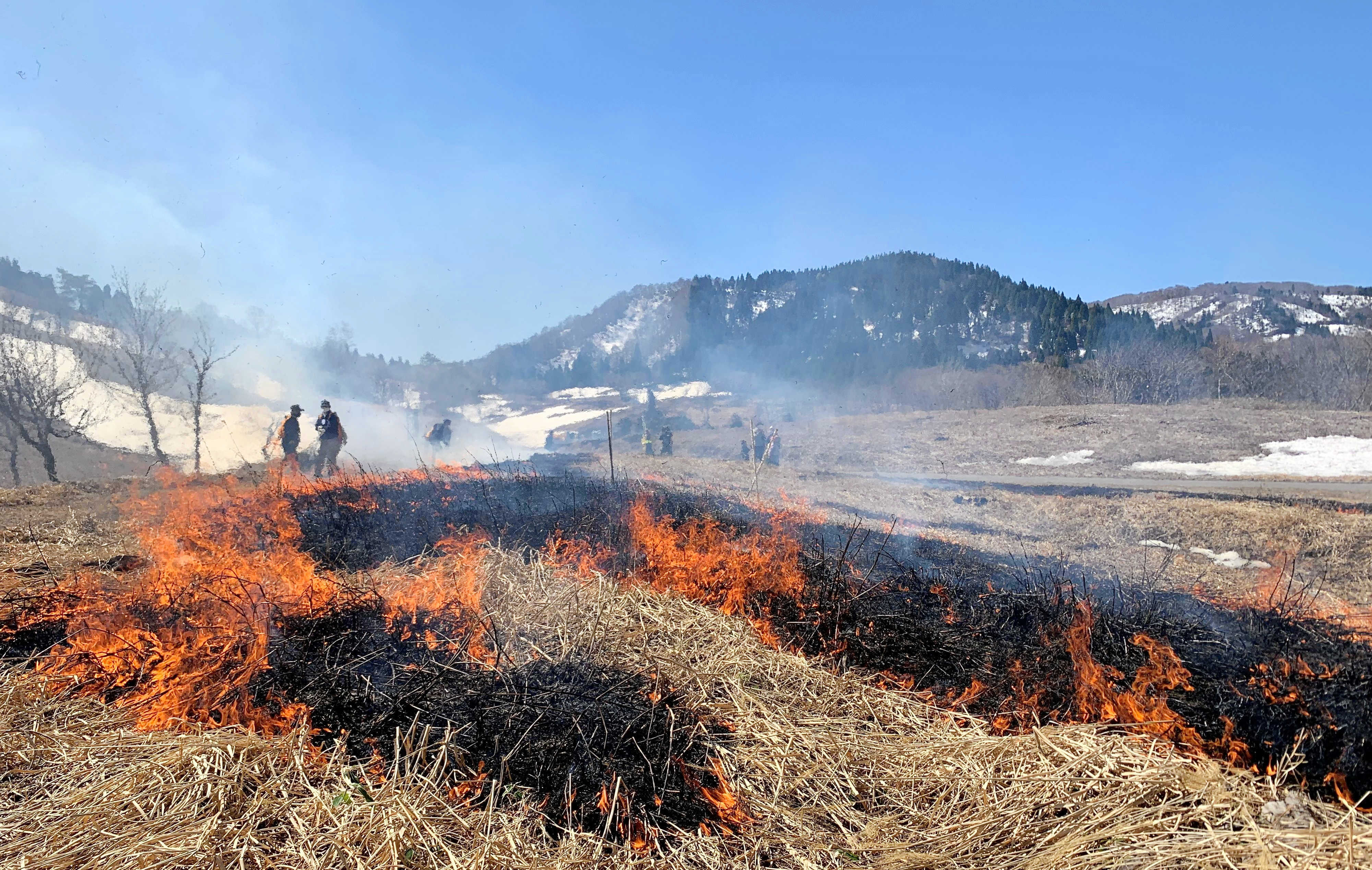Tajima Cattle People, Cattle, Grasslands... A Tale of a Thousand Years
In mid-April, upon a background of snow yet to melt away, Ueyama Kogen Highlands in Mikata District, Shin-Onsen Town, Hyogo celebrated the start of the mountain-climbing season. Local residents lit the yama-yaki, or mountain burning, fire and a ring of flames spread across the gently sloping mountainside. The blackened trail left behind will eventually be covered with new grass, which Tajima cattle will graze upon during the summer. In this article, we will dive into the thousand-year history of the origin of Hyogo’s world-class Japanese beef, Tajima cattle, and its connection with people and the grasslands.

The annual spring yama-yaki used for grasslands restoration, Ueyama Kogen Highlands, Shin-Onsen Town, Hyogo Prefecture
Located in the Ueyama Kogen Highlands, located about 900 meters above sea level near the border of Tottori Prefecture, is a non-profit organization formed by local residents called the Ueyama Kogen Eco Museum. This organization is working with the town and prefecture to restore susuki, or pampas grass, and other plants over approximately 400 hectares. Along with the harvesting of hard grasses and shrubs, mountain burning is essential for grassland restoration.
These efforts stem from the grasslands, which the local elderly remember as a vast landscape. “It was completely different from what you see today, before the area was covered with cedar and other man-made forests. There were places here and there where beautiful grasslands continued all the way to the top of the mountain. And when you crossed the top, you would be met by the grasslands of the opposite village.” NPO advisor Kazuyuki Obata said he used to look up at the grazing Tajima cattle and smoke from the burning fields from the foot of the mountain when he was a child after the war.
While gathering information on Mikata District (Shin-Onsen Town and Kami Town), the place where Tajima cattle was born and the source of Kobe Beef and other beef products, we also happened to stumble upon another story. A story of grasslands that have been shaped by the lives of people and cattle.
Controlled Burning and Grazing
Yoshihiro Sawada, Chief Landscape & Horticulture Specialist at the Hyogo Prefectural Awaji Landscape Planning & Horticulture Academy, explains, “Grasslands do not form naturally. They have continued to exist because cattle use them to graze and people utilize them as resources, such as for kayabuki (thatched roof houses).”
In order to have Tajima cattle work in the mountainous areas for transporting goods and farming, they needed to turn about half of the mountainous area into grasslands. The other half was used for beech and other kinds of wood as wood fuel forests for cooking and heating.
However, with the energy revolution of the 1950s, when fossil fuels and electricity became widespread along with the increase of cars and agricultural machinery, the value of grasslands and wood fuel forests dropped, and cedar and other trees for construction were planted in their place. In addition, cattle were now exclusively used as beef cattle, and they were kept for longer periods in barns with a focus on an imported diet. The relationship between people, cattle, and grasslands slowly faded, and this millennia-long resource cycle was lost.
High Praise in the Kamakura Period

“The Cattle Museum” with exhibits of Tajima cattle, which established the Wagyu brand in Iwate Prefecture, Maesawa, Oshu City, Iwate Prefecture
The remaining grasslands are now limited to only a few areas, such as ski resorts. One of them is the Tajima Cattle Museum at the Hyogo Prefectural Tajima Ranch Park (Shin-Onsen Town).
Tajima cattle appear in the Shoku Nihongi, a collection of history books compiled by Imperial command, in the early Heian period (794-1185). The museum’s reproduction of Kokugyu Juzu (Ten Drawings of National Cattle), created in the Kamakura period (1185-1333), shows that Tajima cattle were already highly regarded as cart-pulling cattle. The museum’s deputy curator, Masanobu Noda, states, “The characteristics of Tajima cattle, with their clean body lines, such as thin skin and slender bones, have not changed."
The museum explains in detail that 99.9% of the black wagyu beef cattle in Japan descended from Tajima cattle. This trend was further advanced during the postwar energy revolution. Agricultural practices were forced to transform in areas producing cattle for farming and military horses throughout Japan, while simultaneously spreading the introduction of Tajima cattle bloodlines in order to create areas that produced beef cattle.
The only cattle-themed museum in Japan, “The Cattle Museum,” in Oshu City, Iwate Prefecture, details the history of the Tajima cattle in these kinds of farming villages throughout Japan. Inside the museum, there are detailed exhibits about famous Tajima cattle such as Wajin, Tsunenori, and Kikutani, which were introduced from Mikata District.
Assistant director of the museum, Keisuke Kawada, stated, “Tajima cattle DNA, which first established Iwate's wagyu beef brands such as Maesawa beef, was passed down via the bulls. We are planning to open a special exhibition in July on Tajima cattle as the origin of wagyu beef.”
Landscape of Dancing Golden Eagles
As a result of the reduction of grasslands, which reportedly accounted for 30% of the country's land area in the Meiji Era (1868-1912) and has now decreased to 1%, the plants and animals that had once thrived on the grasslands now faced the threat of extinction. These include precious highland plants, butterflies and other insects, rabbits and other small animals, and at the top of the list is the golden eagle.
As efforts to protect grassland ecosystems spreads throughout Japan, the history of the people, cattle, and grasslands that have shaped these environments has been receiving renewed attention. In addition, grazing on abandoned fields also improves the health of cattle and also helps prevent damage caused by wild animals. Due to these advantages, there is a growing trend in the agricultural world to reconsider the connection between cattle and grasslands.
At the National Grassland Summit Symposium held in 2016 at Ueyama Kogen Highlands, the grassland restoration vision was discussed, transcending the vertical divisions of administrative organizations such as "environment" and "agricultural policy.” The theme of the symposium was "People and Grasslands: Golden Eagles Dance and Tajima Cattle Play." The participants discussed ways to revive the grasslands by reconsidering its value from various perspectives, including the protection of golden eagles, agricultural use of grass resources, and the kayabuki culture.
This year, Hyogo Prefecture will launch the “Tajima Golden Eagle Aid Project,” which will be composed of not only biologists, but also forestry and tourism personnel. Their goal is to restore grasslands and increase the number of rabbits that the golden eagles feed on, both of which are essential for their conservation. Yoshiaki Takeda, honorary professor at Kobe University who continues to monitor the regeneration of the Ueyama Kogen Highlands, points out, "It is necessary to share all of the value that the grasslands can provide, including in industry, tourism, and ecosystem, while also enhancing the attractiveness of its natural environment and attracting the power of young people.”
The grassland landscape, which has continued for more than a thousand years with the help of cattle grazing leisurely upon it, is the original form of symbiosis between people and nature, and can serve as the basis for a sustainable, recycling-oriented society, which is now needed more than ever. We hope that Hyogo, the birthplace of wagyu beef cattle, will help to bring about a new grassland culture for the future.
Written by Kazuyoshi Tsujimoto, Manager of Corporate Planning Department, Senior Staff Writer at The Kobe Shimbun (Daily Newspaper)
This article was first published on 29nd May 2022 in The Kobe Shimbun as part of a series entitled "Wind, Water and Earth...Hyogo's Terroir"
Date : 2024.05.29




